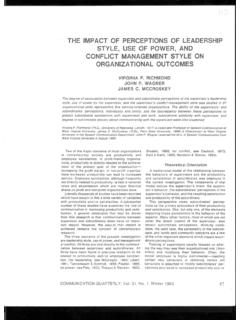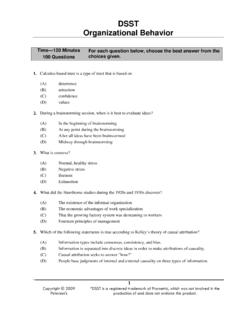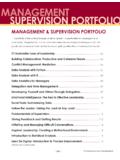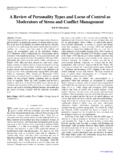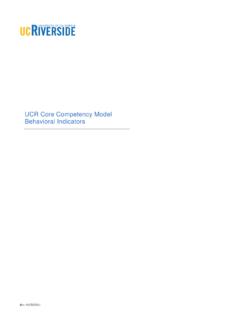Transcription of Determining Your Own NOT FOR SALE OR DISTRIBUTION ...
1 CHAPTER2 Determining your Own Leadership StylePersonally I am always ready to learn, although I do not always like being Winston ChurchillThis chapter introduces the influence of personality and physiology on leadership dynamics. Students are in-troduced to various leadership and personality assessment tests. After completing the assessment tests, studentsare asked to write a summary essay integrating findings of their own leader and personality outcomes. This sum-mary, and the tests that precede it, assist students in identifying a penchant for certain leadership styles presentedlater in the text. The assessments will assist students in understanding and relating to theories, models, and evo-lutionary trends discussed later in this text and in the and describe at least four assessments related to your personality type, leadership style, principles, and foundational skills as informed byleadership and leadership-related assessment results of at least four leadership related assessments and prepare and apply those results to yourleadership and distinguish your leadership style, principles, and foundational skills (both strengths andweaknesses)
2 Based on the results obtained from leadership-related assessment on self-assessments of your personality type, leadership style, principles, and foundational skills,devise a plan to improve your weaknesses while leveraging or enhancing your and interpret your unique leadership persona and relate your leadership persona with examplesfrom your life first step in improving your ability to lead people in health organizations is to understand yourself. To takethat first step, gaining an understanding of your personality type, leadership style, and associated 8/4/10 3:10 PM Page 25 Jones & Bartlett Learning, LLC. NOT FOR SALE OR DISTRIBUTION . Jones & Bartlett Learning, LLCNOT FOR SALE OR DISTRIBUTION Jones & Bartlett Learning, LLCNOT FOR SALE OR DISTRIBUTION Jones & Bartlett Learning, LLCNOT FOR SALE OR DISTRIBUTION Jones & Bartlett Learning, LLCNOT FOR SALE OR DISTRIBUTION Jones & Bartlett Learning, LLCNOT FOR SALE OR DISTRIBUTION Jones & Bartlett Learning, LLCNOT FOR SALE OR DISTRIBUTION Jones & Bartlett Learning, LLCNOT FOR SALE OR DISTRIBUTION Jones & Bartlett Learning, LLCNOT FOR SALE OR DISTRIBUTION Jones & Bartlett Learning, LLCNOT FOR SALE OR DISTRIBUTION Jones & Bartlett Learning, LLCNOT FOR SALE OR DISTRIBUTION Jones & Bartlett Learning.
3 LLCNOT FOR SALE OR DISTRIBUTION Jones & Bartlett Learning, LLCNOT FOR SALE OR DISTRIBUTION Jones & Bartlett Learning, LLCNOT FOR SALE OR DISTRIBUTION Jones & Bartlett Learning, LLCNOT FOR SALE OR DISTRIBUTION Jones & Bartlett Learning, LLCNOT FOR SALE OR DISTRIBUTION Jones & Bartlett Learning, LLCNOT FOR SALE OR DISTRIBUTION Jones & Bartlett Learning, LLCNOT FOR SALE OR DISTRIBUTION Jones & Bartlett Learning, LLCNOT FOR SALE OR DISTRIBUTION Jones & Bartlett Learning, LLCNOT FOR SALE OR DISTRIBUTION Jones & Bartlett Learning, LLCNOT FOR SALE OR DISTRIBUTION skills is paramount. It matters what you know, who you know, and, perhaps most importantly, what you knowabout yourself!
4 1 This chapter starts the journey to understand yourself. As part of this effort, by identifying yourstrengths, weaknesses, and propensities, you can work to become a better leader by adding knowledge, skills, andabilities to your leadership toolbox. This is a lifelong endeavor. Just as you have a dominant personality (thepersonality you naturally have), so you also have a dominant leadership style, a dominant conflict managementstyle, and so forth. Even so, you can learn, practice, and master other styles, which then become part of yourrepertoire to lead people and manage your journey to understanding yourself, this chapter introduces a variety of assessment-relatedtopics: the Myers Briggs personality indicator, introvertedness and extrovertedness (Type A/B personalityindicators), creative and empirical thinkers (left- and right-brain thinkers), and the propensity to lead and learn through visual, auditory, reading, or kinesthetic (VARK) constructs.
5 Prior to completing the leadership-related assessments, students are asked to complete the enneagram diagnostic to discern whether their per-sonal motivational objectives mirror those of traditional leaders. The supplement to this text, available , provides additional assessments as final assessments focus on the test taker s propensity and affiliation in relationship to traditional lead-ership or traditional managerial roles. Other assessments provide diagnostics that evaluate risk taking, charisma,vision, and empirical leadership characteristics. This chapter also discusses the constant battle a leader experi-ences between his or her natural predispositions and the precepts taught in leadership training and mechanicalexecution.
6 While we do not present these tests as a panacea for leadership diagnosis, we do suggest that certainability job fit characteristics may become clearer after completing these THYSELF: WHAT KIND OF LEADER ARE YOU?Newt Gingrich, the former Republican Speaker of the House of Representative, once said of former Demo-cratic President Bill Clinton that he did not like to talk with Clinton for too long a period of time, because after awhile he began to agree with former White House Press Secretary George Stephanopoulos mayhave made this comment jovially in his book All Too Human,the statement was fundamentally accurate in moreways than one. President Clinton was widely admired for his natural charisma, political savvy, and social skills thatinspired followership and easy friendship.
7 The same might not be true of his spouse, Secretary of State Hillary Clin-ton,3who has grown and matured in political creditability through nearly two decades of on-the-job leader train-ing coupled with personal and professional self-development. What one leader possesses intrinsically andnaturally, the other honed through application of best practices and understanding of leadership styles, princi-ples, and skills. In other words, some leaders have natural abilities, while others must work to learn those leaders regardless of their natural abilities, experience, education, and training must be aware oftheir own personal areas for improvement so that they can grow and become more successful.
8 As a result, weask you to consider the following questions:jWhat kind of leader are you?jWhat are your strengths and weaknesses?jAre you aware of how those strengths and weaknesses support or fail to support your leadership style?Traits of LeadersThere is an ongoing debate, within both the literature and professional practice, over whether leaders are bornor made. This argument centers on the premise that those qualities that make leaders successful cannot betaught. Such qualities might include ambition, motivation, and a strong work is a general agreement in the literature that these qualities are inherent within individuals whoemerge as leaders in the organizational workplace.
9 Certainly, many great leaders of our time have possessed these26 CHAPTER 2nDetermining your Own Leadership 8/4/10 3:10 PM Page 26 Jones & Bartlett Learning, LLC. NOT FOR SALE OR DISTRIBUTION . Jones & Bartlett Learning, LLCNOT FOR SALE OR DISTRIBUTION Jones & Bartlett Learning, LLCNOT FOR SALE OR DISTRIBUTION Jones & Bartlett Learning, LLCNOT FOR SALE OR DISTRIBUTION Jones & Bartlett Learning, LLCNOT FOR SALE OR DISTRIBUTION Jones & Bartlett Learning, LLCNOT FOR SALE OR DISTRIBUTION Jones & Bartlett Learning, LLCNOT FOR SALE OR DISTRIBUTION Jones & Bartlett Learning, LLCNOT FOR SALE OR DISTRIBUTION Jones & Bartlett Learning, LLCNOT FOR SALE OR DISTRIBUTION Jones & Bartlett Learning, LLCNOT FOR SALE OR DISTRIBUTION Jones & Bartlett Learning, LLCNOT FOR SALE OR DISTRIBUTION Jones & Bartlett Learning.
10 LLCNOT FOR SALE OR DISTRIBUTION Jones & Bartlett Learning, LLCNOT FOR SALE OR DISTRIBUTION Jones & Bartlett Learning, LLCNOT FOR SALE OR DISTRIBUTION Jones & Bartlett Learning, LLCNOT FOR SALE OR DISTRIBUTION Jones & Bartlett Learning, LLCNOT FOR SALE OR DISTRIBUTION Jones & Bartlett Learning, LLCNOT FOR SALE OR DISTRIBUTION Jones & Bartlett Learning, LLCNOT FOR SALE OR DISTRIBUTION Jones & Bartlett Learning, LLCNOT FOR SALE OR DISTRIBUTION Jones & Bartlett Learning, LLCNOT FOR SALE OR DISTRIBUTION Jones & Bartlett Learning, LLCNOT FOR SALE OR DISTRIBUTION qualities. However, qualities or traits of motivation, ambition, and work ethic are difficult to measure bythemselves.










